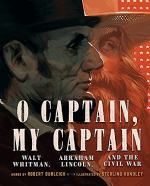
|
| Name: _________________________ | Period: ___________________ |
This test consists of 5 multiple choice questions, 5 short answer questions, and 5 short essay questions.
Multiple Choice Questions
1. Which term describes the poem's repeated use of the phrases "O Captain! My Captain!" (lines 1 and 9) and "fallen cold and dead" (lines 8, 16, and 24)?
(a) Chorus.
(b) Verse.
(c) Conceit.
(d) Refrain.
2. The list of ways the crowd is celebrating the arrival of the ship in lines 9-12 is an example of which technique?
(a) Accumulation.
(b) Understatement.
(c) Periphrasis.
(d) Paraprosdokian.
3. Which is the best interpretation of line 9, when the speaker urges "O Captain! my Captain! rise up and hear the bells"?
(a) The speaker is having trouble accepting what has happened.
(b) The speaker is not yet aware that the captain has died.
(c) The speaker realizes that the captain is not actually dead yet.
(d) The speaker is addressing the captain's spirit or ghost.
4. The poem's title and first line contain an example of which technique?
(a) Apostrophe.
(b) Synechdoche.
(c) Simile.
(d) Personification.
5. What is the rhyme pattern of the first four lines of each stanza?
(a) ABCB.
(b) AABB.
(c) ABBA.
(d) ABAC.
Short Answer Questions
1. Which technique is evident in line 10, "Rise up—for you the flag is flung—for you the bugle trills"?
2. What type of rhyme is employed in line 20, "From fearful trip the victor ship comes in with object won"?
3. Which details in the second stanza evoke a patriotic occasion?
4. In context, the word "fearful" in line 1 indicates that the trip was which of the following?
5. Which technique is evident in the phrase "for you the flag is flung" (line 10)?
Short Essay Questions
1. What elements of the poem's diction establish a warm and personal relationship between the speaker and the captain?
2. Describe the form of "O Captain! My Captain!"
3. What evidence is there that the speaker is struggling to understand and process the captain's death?
4. Explain the allegorical nature of the poem's central conceit.
5. What ironic contrast do the poem's images highlight?
|
This section contains 676 words (approx. 3 pages at 300 words per page) |

|




